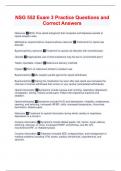NSG 552 Exam 3 Practice Questions and
Correct Answers
Naloxone ✅MOA: Pure opioid antagonist that competes and displaces opioids at
opioid receptor sites.
Methadone, buprenorphine, buprenorphine+naloxone ✅Treatments for opioid use
disorder.
Buprenorphine+naloxone ✅Treatment for opioid use disorder with comorbid pain.
Opioids ✅Inappropriate use of what substance may be due to uncontrolled pain?
Tablet, injectable, implant ✅Naltrexone delivery methods.
Implant ✅Form of naltrexone limited to inpatient use.
Buprenorphine ✅Mu receptor partial agonist for opioid withdrawal.
Buprenorphine ✅Taking this medication too soon after last opioid use increases the
chances of intense withdrawal that comes on very quickly (precipitated withdrawal).
Opioid intoxication ✅Symptoms include nausea and vomiting, respiratory depression,
constipation, itching, mioisis (small pupil). Patient will experience euphoria and
sedation.
Opioid withdrawal ✅Symptoms include N/V/D and dehydration, irritability, restlessness,
yawning, and twitching, increased HR/BP, chills, increased temperature, rhinorrhea,
lacrimation, dilated pupils.
Naloxone ✅Treatment for opioid intoxication during which cardiac or respiratory
depression is a concern.
Cocaine intoxication ✅Symptoms include dilated pupils, HA, tremor, hyper-reflexia,
twitching, seizures, or coma, increased HR/BP, arrhythmias, and MI, N/V,
incontinence/ARF, or rhabdomyolysis
Cocaine intoxication ✅Treatment includes BZD, antipsychotics, and management of
medical problems including HTN, stroke, cardiac arrhythmias, hyperthermia, and
seizures.
, Cocaine ✅The use of beta blockers for treatment of chest pain and MI during this
intoxication is to be avoided due to unopposed a adrenergic stimulation.
Alcohol intoxication ✅Signs vary with blood levels, from decreased reaction time,
muscle incoordination, ataxia, dysarthria, to respiratory failure and coma.
Severe alcohol intoxication ✅Treatment includes cardiopulmonary function
maintenance, thiamine, and haloperidol PRN agitation.
Thiamine ✅Given IM/IV for 3 days to prevent Wernicke's encephalopathy, along with
IV fluids and a banana bag.
Benzodiazepines ✅Class of drugs to avoid for acute alcohol intoxication.
Uncomplicated alcohol withdrawal ✅Treatment includes BZD in either symptom
triggered or fixed dose; diazepam and chlordiazepoxide have a longer half life, and
oxazepam and lorazepam are suitable for patients with hepatic dysfunction.
Diazepam and chlordiazepoxide ✅bzds with a long half-life used to treat AUD.
Oxazepam and lorazepam ✅bzds with moderate half-life used in AUD patients with
liver disease.
Alcohol withdrawal seizures ✅Treatment includes diazepam IV or lorazepam IV/IM,
thiamine IV/IM, and addressing electrolyte imbalances.
DT ✅Treatment includes acute care management, parenteral diazepam or lorazepam,
thiamine, and antipsychotics if necessary.
Disulfiram ✅MOA is via negative reinforcement, where drinking is avoided due to
unpleasant effects.
Acamprosate ✅NMDA receptor antagonist that is renally cleared, suitable for AUD
patients with hepatic dysfunction.
Naltrexone ✅Treatment suitable for AUD with comorbid OUD, reducing consumption
by decreasing reinforcing properties.
NRT ✅Only deals with physical dependence, does not address the psychological
component of smoking.
Varenicline, bupropion, clonidine ✅Oral stop-smoking aids, remember *Very Bad
Cancer*





